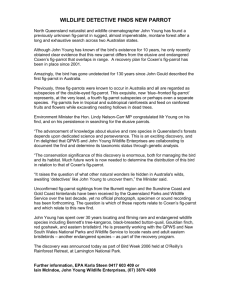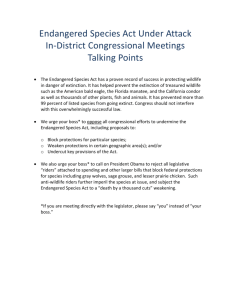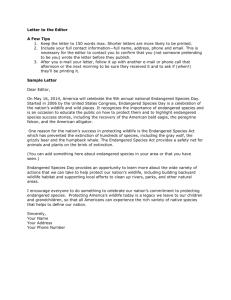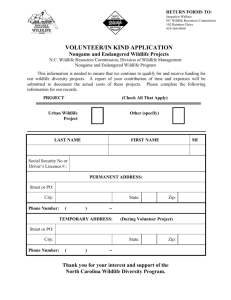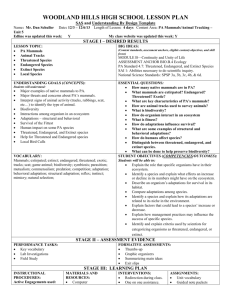Trade in Wildlife Parts History
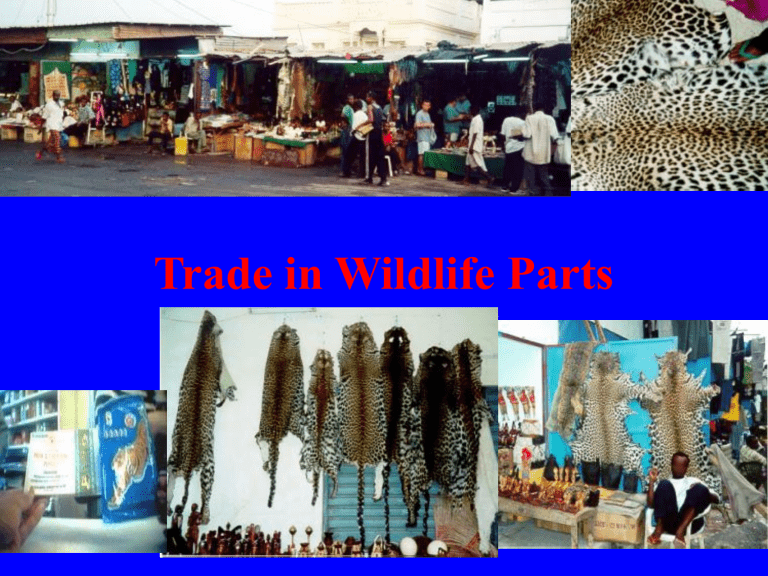
Trade in Wildlife Parts
History
History
•Back in the day (colonization of NA)
– Mostly pelts, antlers, and horns
– For guns, traps, pots and pans, and other necessities necessities populations
History cont’d
• Exploitation went on for many years
• Only after many wildlife numbers decreased dramatically did the gov’t step in
• Began with setting aside land for National preserves
– Created many different laws pertaining to wildlife
Laws
• 1 st major law: Lacy Act (1900)
- regulates interstate and international trade of wildlife and wildlife parts (dead or alive)
• Migratory Bird Treaty Act (1916)
- protects migratory bird species in Canada,
Mexico, and the US
Laws cont’d
• Duck Stamp Act (1934)
- to supplement and support Migratory Bird
Act
- Funds from duck stamp set aside to buy land for wildlife sanctuaries (mostly wetland habitats)
Laws
• Endangered Species Act (1973)
- Purpose:
- To conserve habitats that endangered species depend on
- To create programs to conserve endangered/threatened species
- To uphold other treaties/conventions
Endangered Species Act
• Policy:
– To conserve endangered/threatened species to uphold this act
– Cooperation between state and federal authorities for conservation
– Prohibition of exporting or importing any endangered/threatened species native to any country
CITES
• Convention on International Trade in Endangered Species (1975)
• Global treaty focusing on protection of plant and animal species form unregulated international trade
CITES
• Three phases
– Protects threatened species from international trade
– Regulates trade in non-threatened species but may become threatened if trade goes on
– Gives countries options of species to list if already protected within boundaries
International Trade
• Main importers: South East Asia, Europe, and US
• Main exporters: South America, US, and
Africa
ASIA
internationally and intranationally and intranationally
– Biggest problematic country
-biggest problematic country
ASIA
• Rural problems
– Not a lot of money
– Know that wildlife parts = big money
– Used to and still hunt for subsistence
– Sell/trade parts for food, salt, guns, etc.
– Belief of success in next hunt if have skulls
ASIA
• City problems
– Too much money
– Want traditional medicines
– Want to be like western peoples (US)
--Trophies etc.
ASIA
• Main mammals poached in SE Asia:
– Tigers
– Tibetan antelope and gazelle
– Giant panda
– Rhinos
– Tapirs
– Musk deer
– Various monkeys
Brain: laziness and pimples
Tigers
Hair: when burnt chases away centipedes
Skin: treat mental illness
Whiskers: toothaches
Bones: arthritis, strengthen muscles
Stomach: calm upset stomach
Tail: various skin diseases
Other mammals:
-- skins sold for
$100,000 US
Tapir:
-- skin used to remove boils and keep away infections
More mammals:
Tibetan antelope:
-fashionable hides
-- called Shahtoosh
-- In 1992, $2750 /lb
-- 20000 killed annually (1999 )
-exported to Italy,
France
Sumatran Rhino:
-- horn: relieves headaches and fevers
More mammals:
Musk deer:
-- musk gland used
-- to treat malaria,
Gibbons and macaques:
--skins made into shoulder bags convulsions
-- treatment for
-- perfume to malaria
Germany, France
-- $ 45,000 /kg
Solutions (possible)
• A college in San Francisco started promoting alternative ingredients for traditional medicines
• Actually pay people to work in national preserves
• Give people salt to safeguard wildlife
AFRICA
• Declined in exporting 1980’s – 1990’s
• Recent increase due to lifted ban on ivory
• Main problems:
-- civil war
-- hunting (subsistence)
-- lack of funding
AFRICAN MAMMALS
• Main mammals effected in Africa
– Elephants
– Black and White Rhinoceros
– Gorillas and other primates
– Cheetahs and other big cats
ELEPHANT elephant
•Hunted for ivory jewelry piano keys carvings
•Hunted for meat
RHINOCEROS
Hunted for : horns
- medicinal value
- dagger handles meat trade
Gorillas and other primates gorilla
Hunted for: meat hands and other body parts young ones capture for zoos and private collections
Cheetahs and other big cats
• Hides used for trade
• Meat used to sell to other tribes
• Killed for predation on cattle
Africa
Solutions:
• Burning stacks of horns to curb hunting
• Cutting of rhino horns before they get big accidental deaths
Africa
More Solutions:
• Hippo teeth and warthog tusks for ivory
• DNA tracking of ivory
– New tests help differentiate elephant ivory from mammoth ivory (which is legal)
– Tests also locate approximate location of kill
SOUTH AMERICA
• Recent member to illegal trade family
• Mostly trade for money
• Lack of education about endangered species
South America
• Brazil
– Mostly bird smuggling: parrots, etc.
• Venezuela:
– Mostly bird smuggling
– Few mammals being smuggled
– Just hides and other parts: ocelot skins
South America
• Problems:
– Increase of population size
– Decrease value of money
– Had to increase exporting something
– Rise in unemployment = need for cheep food
= native species
SA Mammals
CAPYBARA:
• Hide used for leather products
• Considered a delicacy
OCELOT:
• Pelts used in fur industry
• Trapped for house cats
South America
• Another major problem:
– Drug lords getting in on trade
– Good, quick money
– Stuffing drugs and other paraphernalia into mounted species
South America
Solutions:
-- Find other products to export (oil, minerals, etc.)
-- help their economy
-- increase value of their money
-- employ more people
North American Trade
Intro to North America
• World’s largest importing/exporting region in the world.
• Trade is about 20 billion dollars worldwide, second only to narcotics.
• Discovery by European nations 300 years ago.
• Historically fur- Highest value commercially in the world.
United States
• High demand for live animals and exotic leathers.
• Largest wildlife consuming country in world.
• Center of commerce for worlds animals and plants.
• Canada and Mexico play similar roles but on a smaller scale.
Trade
• Two types usually
• Legal
• Illegal
• Majority of trade is illegal
• Many rules/regulations restricting trade.
• Some categories subject to restrictions are:
• Mammals, birds, amphibians, fish, insect, crustaceans, etc.
• Also any products manufactured from wildlife like feathers, skins, and eggs.
Trade
• Designated ports for entry.
• Baltimore, Chicago, Dallas, Honolulu, Los
Angeles, Miami, New Orleans, New York,
San Francisco, and Seattle.
• Must have containers marked and labeled to show name of shipper and consignee and number and kind of contents.
Illegal Trade
• One third of world’s wildlife is in danger of extinction because of illegal trade.
• Profit is high, risk of getting caught is low.
• Animals worth more dead than alive.
• The more endangered, the more valuable.
Illegal Trade
• Worth more than $5 billion per year in the
U.S.
• Most people involved are also involved with organized crimes like drugs and prostitution.
• Supplies are diminishing. Heading to
Canada for supplies.
Canada
• Many Canadian animals are in high demand.
• National Parks are supermarket for major trophy heads.
• Animals are grown protected, now they are major target for poachers.
Targets
• High price getters
• Bighorn, Elk, Moose, Deer, Goats, and
Bears.
• Also Fetuses, antlers and velvet, deer hooves, predatory bird feathers, gall bladders, teeth, paws, and claws of bears.
• Bears are one of main targets.
Black Bear
• Mainly targeted for gall bladder.
• Trade is similar to heroin, only scarcer.
• Valued part- bile
• Traditional medicines to treat burns, fever, stomach ulcers, heart disease, cancer, gall bladder problems, and hemorrhoids.
Black Bears
• Flight from Toronto to
New Delhi crashed June
22, 1985.
• Two suitcases with gall bladders from 1,000 black bears was lost.
• 70 pounds
• $1 million in gall bladders
• Bear paws are also taken.
Poaching
• California population is decreasing.
• Biggest factor said to be poaching due to value of gall bladders.
• Most go to China
Viagra Involved??
• Thought to slow use of animal parts from endangered species for aphrodisiacs.
• Slowed trade in harp seals genitals
• Claimed to be reason for market drying up.
• 10 years ago- $65 a piece. 8 years later- $6
• Found viagra had very little impact.
• Decline underway before 1998.
Seals
• 92,000 killed last year in newfoundland.
• 282,000 in 1998
• Reduced numbers caused by poor ice and oversaturated market.
• Now hunting/trade on rebound in Canada
• 214,000 this year already.
• $27 a piece. Up from $8.50 a year ago
• Set a legal quota on number to be taken.

